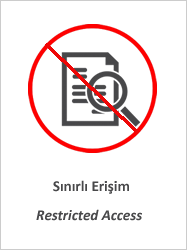Morphometric measurements of the hip bone in turkish adult population

View/
Access
info:eu-repo/semantics/closedAccessDate
2018Author
Demir, MehmetAtay, Emre
Güneri, Bülent
Yılmaz, Halil
Arpacı, Muhammed Furkan
Susar Güler, Hatice
Al, Özge
Ertekin, Tolga
Nisari, Mehtap
Unur, Erdoğan
Metadata
Show full item recordAbstract
Objectives: Coxal bone paticipates in the formation of the pelvic skeleton. Anatomy knowledge on coxafemoral joint as well as careful history taking and physical examination are crucial in evaluation and management of disorders involving hip joint. The aims of the present study were to perform morphometric measurements of the human coxal bones, calculation of their articular surface areas and report the range of these parameters regarding Turkish adult population. Methods: Seventy-two dry human adult coxal bones (39 left and 33 right) from the Anatomy Departments of Erciyes University, Inonu University and Kahramanmaras Sutcu Imam University were measured using a caliper sensitive to 0.1 mm. Morphometric measurements were performed through 22 parameters determined. While 19 of these parameters were related to the distance between two points and thicknesses in various parts of the bone, the remaining three were related to the determination of articular surface areas. The articular surface areas of hip bone (facies auricularis (FA), facies lunata (FL) and facies symphsialis (FS)) were calculated with ImageJ software program. Results: The average values of facies auricularis area were 1659.04 ± 470.92 mm 2 and 1637.32 ± 460.15 mm 2 on the left and right coxal bones, respectively. No statistically significant difference was determined between the left and right coxal bone measurements (p > 0.05). We found a positive and significant correlation between articular surface areas of facies auricularis (FA), facies lunata (FL) and facies symphysialis (FS) and maximum width of ilium (rFA = 0.299, rFL = 0.276, rFS = 0.375, respectively and p ? 0.05), and distance between spina ilica anterior superior and the upper edge of facies symphysialis (rFA = 0.268, rFL = 0.511, rFS = 0.482, respectively and p ? 0.05). Conclusion: The distribution and mean values of coxal bone morphometric measurements usually differ between individuals and human populations. With this regard, orthopedic surgeons should be aware of the diversity in components of coxal bone dimensions although implants and hip prosthesis components of different sizes are manufactured. Safe routes and estimated distances should be considered during surgical procedures to avoid complications. © 2018, Kobe University School of Medicine. All rights reserved.















